Above: Tires on a Boeing 737 (Wikimedia Commons/Politikaner)
Above: Tires on a Boeing 737 (Wikimedia Commons/Politikaner)
Shakib Rahman
Readability
4.75
| Grade | Course | Topic |
|---|
AB 6 Science 1-6 (1996) Topic B. Flight
MB 6 Science Grade 6 (2000) Cluster 2: Flight
NL 6 Grade 6 Science (2018) Unit 2: Flight
NS 6 Science 6 (2019) Physical Science: Flight
NU 6 K-6 Science and Technology Curriculum (NWT, 2004) Matter and Materials: Properties of Air and Characteristics of Flight
PE 6 Science Grade 6 (2012) Earth and Space Science: Flight
SK 6 Science Grade 6 (2009) Physical Science – Principles of Flight (FL)
NT 6 K-6 Science and Technology Curriculum (NWT, 2004) Matter and Materials: Properties of Air and Characteristics of Flight
ON 6 Science and Technology, Grade 6 (2022) Strand D: Flight
QC Sec IV Applied Science and Technology The Technological World
QC Sec I Science and Technology Technological world: Engineering
QC Sec II Science and Technology Technological world: Engineering
AB 7 Science 7-8-9 (2003, updated 2014) Unit C: Heat and Temperature
MB 7 Science Grade 7 (2000) Cluster 2: Particle Theory of Matter
NB 7 Science 7: Earth Surface Processes (2020) Matter
NB 9 Science 9: Ecosystem Dynamics (2020) Ecosystems: Energy, Matter and Interactions
NL 7 Science Grade 7 (2013) Unit 2: Heat and Temperature
NS 8 Science Grade 8 (2020) Learners will create a model that demonstrates the principles of kinetic molecular theory.
NU 7 Science 7 (Alberta, 2003, updated 2014) Unit C: Heat and Temperature
ON 7 Science and Technology, Grades 1-8 (2007) Heat in the Environment
PE 7 Science Grade 7 (revised 2016) Physical Science: Heat
SK 7 Science Grade 7 (2009) Physical Science – Heat and Temperature (HT)
ON 7 Science and Technology, Grade 7 (2022) Strand E: Heat in the Environment
NT 7 Science 7 (Alberta, 2003, updated 2014) Unit C: Heat and Temperature
Manufacturing and engineering airplane tires is important work! Learn how airplane tires keep the aircraft safe during takeoff and landing.
Have you ever flown in an airplane? If so, you have felt that funny bump when you touch down at the end of the journey. But have you ever wondered how airplane tires handle all that stress and pressure? Why don’t they burst on contact with the hard runway? Well, airplane tires need to be specially designed. Thanks to their design, they are strong enough to stay intact during takeoff and landing.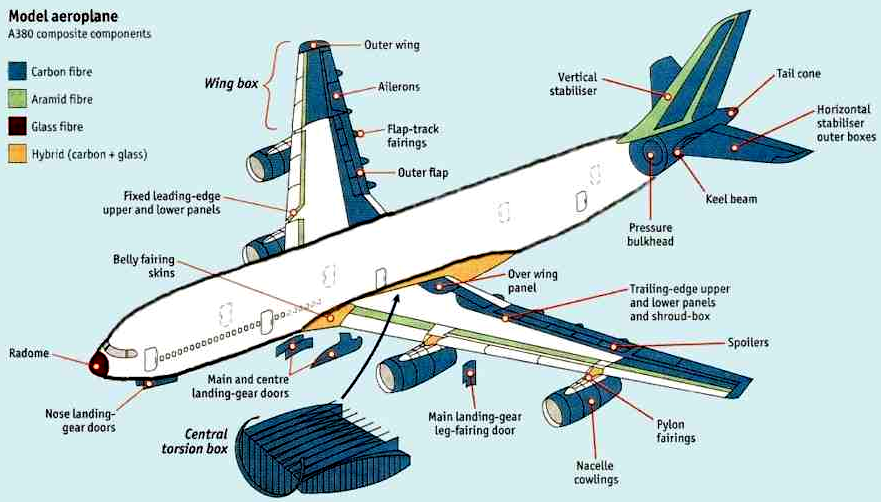
Did you know?
Airplane tires are made by hand.
Airplane tires are very different from car, truck or bicycle tires. In fact, airplane tires have about as much in common with these tires as they do with running shoes! They are all made of rubber. They all contain air. They all provide support and cushioning for what’s on top of them. But that's where the similarities end.
Tires on a Boeing 777 (Source: Dmirty A. Mottl [CC BY-SA 3.0] via from Wikimedia Commons).When a plane lands, airplane tires have to support the weight of the airplane and all the people in it.
Did you know?
The passengers and cargo in an airplane are called the payload.
Airplane tires have to deal with enormous forces when the plane lands. They especially have to deal with friction. Friction occurs when two surfaces move against each other, like when you rub your hands together.
Airplane tires create friction when they hit the runway. This friction generates heat. It also and wears down the outside layer of the tire. Because of this, airplane tires are reinforced with strong, flexible materials. One of these materials is a super-strong plastic called Kevlar. Kevlar is strong, flexible, heat-resistant and lightweight.
It’s important for airplane tires to be flexible. Flexibility lets airplane tires absorb more of the shock of landing. Flexibility also slows the wearing down of tires.
Main landing gear of a C-160 Transall transport airplane (Source: Scott Taylor, used with permission).Airplane tires also have conducting strips built into the tire grooves. These strips discharge any electric charges that may have built up. This is important. If static electricity were to build up during takeoff or landing, it could cause a spark. A spark could ignite the fuel in the plane!
Slowmotion Landings (2013) by pilotdynan (1:40 min.).Airplane tires are also protected by what’s inside. Usually, they are filled with nitrogen. Nitrogen is a non-flammable gas. It doesn’t corrode the metal parts of a plane. Nitrogen also doesn’t oxidize (break down) the rubber in the tires. The tires themselves are made from at least three layers of rubber. Each layer is laid down in a different direction. This makes the tire stronger and gives it better traction when it lands.
Airplane tires also have six times more pressure than car tires do.
But airplane tires are more than just rubber (and Kevlar). They can have 14 different parts. Each of these parts serves a specific purpose in making takeoffs and landings safer and easier.
The typical airplane tire can go through about 500 landings before it needs to be repaired. Usually, the top layer of tread is simply peeled off and replaced with new tread. That way, the other parts don’t need to be replaced.That’s a good thing, because the other parts are very expensive.
That way, the other parts don’t need to be replaced.That’s a good thing, because the other parts are very expensive.
CESSNA 172 - 3 TIRES
BOEING 777 - 14 TIRES
AIRBUS A380 - 22 TIRES
ANTONOV AN-225 - 32 TIRES
Source: Aircraft Owners and Pilots Association
So the next time you see an airplane in the sky, think about its tires. Remember, there is a lot of engineering that goes into them. This helps the plane take off and land safely!
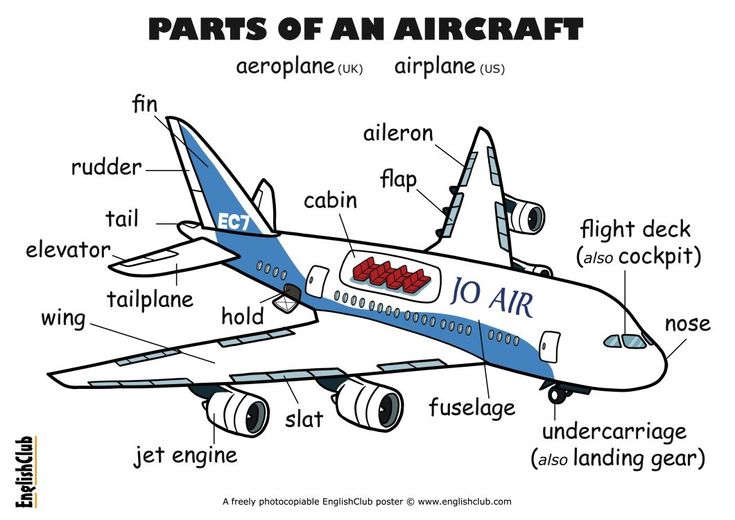 Concepts introduced include design, payload, forces, friction, Kevlar, discharge, electric charge, nitrogen, oxidize and pressure.
Concepts introduced include design, payload, forces, friction, Kevlar, discharge, electric charge, nitrogen, oxidize and pressure. 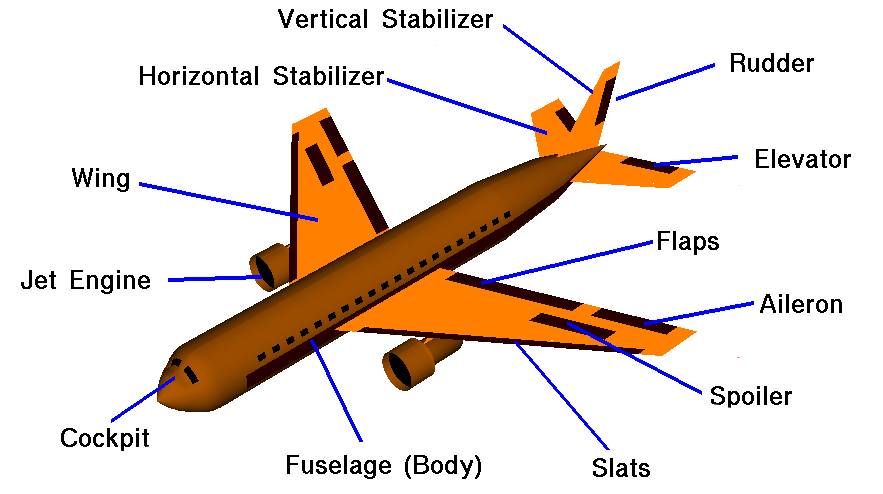 Concepts introduced include design, payload, forces, friction, Kevlar, discharge, electric charge, nitrogen, oxidize and pressure.
Concepts introduced include design, payload, forces, friction, Kevlar, discharge, electric charge, nitrogen, oxidize and pressure. Airplane tires need to be able to withstand extremely heavy loads as they hit the ground as an aircraft lands.
Due to this, they need to be replaced, or at the very least retreaded or recapped, more often than the tires used in other modes of transportation.
There are a few factors that influence just how long airline tires will last, so it’s difficult to state a definitive lifetime.
Let’s take a look at these factors.
Every time a commercial airliner lands, its tires are put under a much heavier load than most aircraft.
This means that the tires used on commercial airplanes can last for 200-300 landings, which will be much less than the tires used on lighter aircraft.
An airline can expect to get approximately 300 landings from the tires on an Airbus 380, which is the world’s largest passenger airliner. The amounts to about six months of operation.
A hard landing, which is when an aircraft hits the ground with a greater vertical speed and force than in a normal landing, will inevitably put a heavier load on airline tires and cause them to wear out more quickly.
Hard landings can cause just mild passenger discomfort to serious injury and/or loss of life.
Either way, before an aircraft can take flight again it must be inspected for damage.
A hard landing can therefore cause a great amount of damage to airplane tires.
Crosswind landings, which is when a plane must attempt to land as the wind blows perpendicular to the runway, can also cause tires to wear out more quickly.
This is down to the hard overcorrection and side loading that occurs as an airplane lands.
The tire marks you see on a runway can sometimes be caused by side loading as an aircraft drifts or skips on its side as it lands.
Runways can either be man-made – using asphalt, concrete, or a mixture of the both in their construction- or natural – made of grass, dirt, and gravel.
Both man-made and natural runways can cause problems.
Asphalt runways are susceptible to ruts, which can result in quicker tire wear.
Concrete runways also have their own maintenance challenges too.
Manmade runways can also develop cracks, spalling, and most dangerous of all, potholes, which all contribute to tire wear.
Inevitably, airports carry out a lot of preventative maintenance which can ensure tires won’t suffer any unavoidable damage and will last longer.
But many runways aren’t as well-maintained, especially natural ones, though a grass runway can actually be easier on tires than a concrete or asphalt runway due to its softer surface.
Weather
Bad weather conditions can cause crosswinds and hard landings, which as you now know contribute to airplane tires wearing out more quickly.
So for airplanes that operate in areas that regularly experience gusty winds, for example, their tires can wear out more quickly compared to other locations.
Airplane tires are expensive, so if at all possible, aircraft owners and operators want to avoid completely replacing a tire.
Therefore, in the world of aviation, it’s standard to retread tires (also known as recapping).
As the tread of an airplane tire wears out much more quickly than its casing (everything other than the tread), the logical thing to do is to just retread the tire.
As some airline tires can be retreaded up to seven times, you can see that significant cost savings can result.
Retreading commonly occurs when tires have numerous cuts in the tread area, when there is a badly worn section of the tread (known as the flat spot), or when the tread is evenly worn.
Once all the tires have been retreaded/recapped, you can usually expect them to last for another 100 landings, though some may need to replaced sooner.
A study by Embry-Riddle Aeronautical University found that 99% of airplane tire wear could be eliminated by pre-spinning the tires to closely match the speed an aircraft will be traveling at as it touches down.
So, why hasn’t this been implemented? In short, it’s an idea that sounds better in theory than reality, largely due to it not being particularly cost-efficient.
Installing motors to prespin the tires is not only costly, but also adds more weight to an aircraft.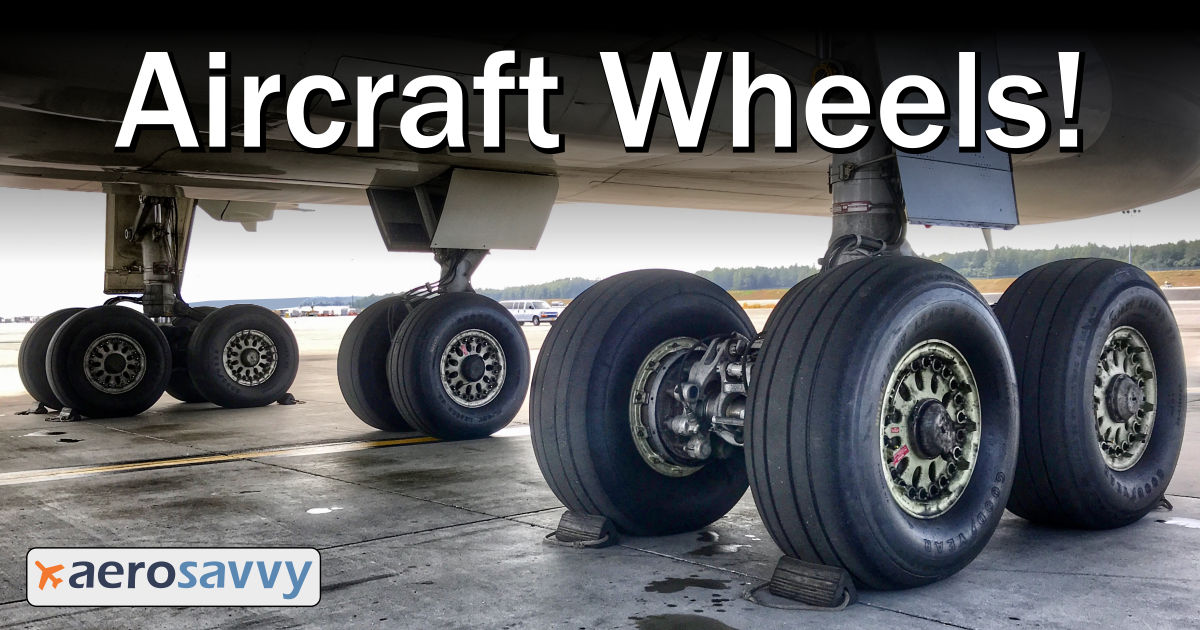 Additional weight results in a greater amount of fuel consumption and therefore higher fuel costs.
Additional weight results in a greater amount of fuel consumption and therefore higher fuel costs.
There are also maintenance costs to consider, as well as there not being very much room inside a wheel rim to install a motor in the first place.
The wheel rim already contains multi-plate disc brakes that take up a large amount of space and can get very hot when the brakes are applied.
This would create a harsh environment for any motor to function, and it would also wear out more quickly.
Replacing, retreading, or recapping airplane tires is simply easier and more economical than attempting to implement a system to extend tire wear.
From a safety point of view, a malfunction of the motor can result in skidding. Spinning airplane wheels also add gyroscopic effects, which can make it harder to line up an airplane with the runway and land safely.
See Also:
 An aircraft tire is a multi-element component constructed from three materials: cord, rubber, and metal. By weight, an aircraft tire is 50% rubber, 45% cord and 5% metal.
An aircraft tire is a multi-element component constructed from three materials: cord, rubber, and metal. By weight, an aircraft tire is 50% rubber, 45% cord and 5% metal. When landing an aircraft, the landing gear experiences not only colossal static but also dynamic loads taken by the struts and wheels. Add to this that during the flight the wheels were motionless, and when touching the runway, they should quickly gain momentum corresponding to the landing speed. Thus, rather high and strict requirements are imposed on the chassis of modern aircraft.
Aircraft tire and wheel assemblies can operate under high pressure to carry the load placed on them and should be handled with the same care as any other pressure vessel. Multiple carcass plies are bonded together to form a common carcass, making the tire capable of holding internal pressure.
By significantly reducing the weight of tires and at the same time increasing the number of landings they can withstand, operating and fuel costs are reduced.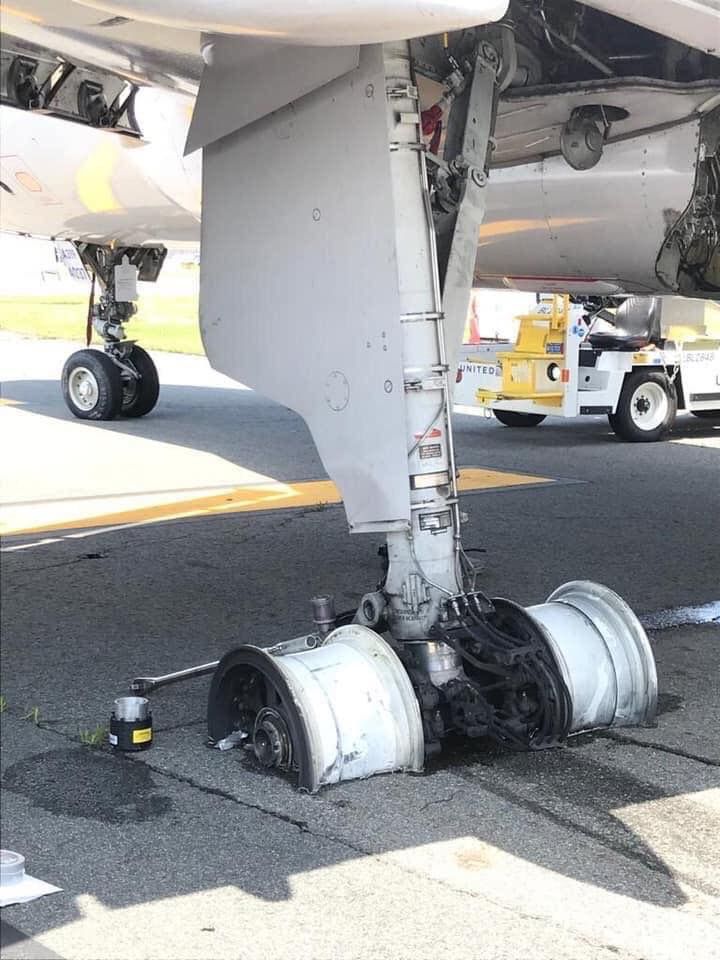 The result is a reduction in the negative impact on the environment by reducing CO2 emissions into the atmosphere and using less raw materials.
The result is a reduction in the negative impact on the environment by reducing CO2 emissions into the atmosphere and using less raw materials.
Suspension struts
The most heavily loaded elements of an aircraft landing gear are suspension struts and wheels (pneumatics).
Suspension struts are used to ensure maximum ride smoothness when driving along the airfield, on takeoff run and run, as well as to dampen shocks that occur at the time of landing (multi-chamber nitrogen-oil long-stroke shock absorbers are often used, in which the function of a spring element is performed by pumped under a strictly defined pressure technical nitrogen). On the multi-wheeled bogies of the landing gear of heavy aircraft, additional shock absorbers can also be installed - stabilizing dampers. Reinforced landing gear is able to withstand impact on the protruding edges of concrete slabs up to 10 cm high when the aircraft is moving at landing speed or a rough landing.
There is also a system of braces, rods and hinges that perceive the reactions of the supporting surface and fasten the shock absorber struts and wheels to the wing and fuselage, which simultaneously serve as a retraction-release mechanism.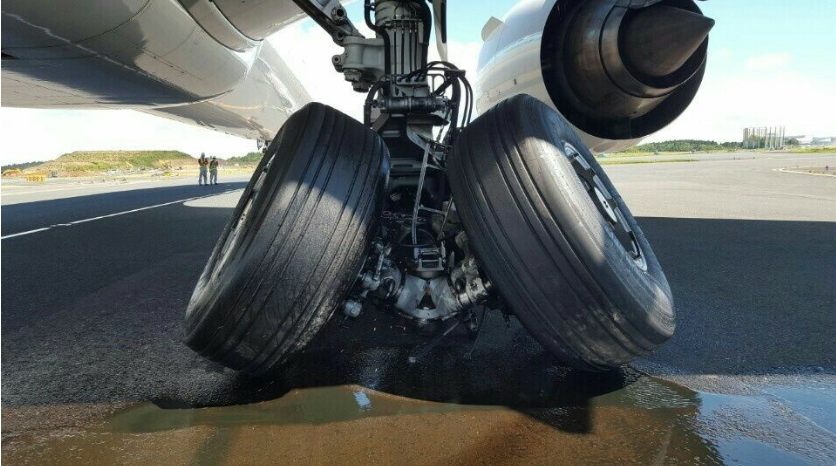
Aircraft landing gear wheels support the aircraft on the ground and provide the means of mobility for takeoff, landing and taxiing. And pneumatic tires, shock-absorbing, protect the aircraft from shock impulses due to surface irregularities and shortcomings in piloting technique during landing.
Wheel disks (drums) are often made of magnesium-based alloys. Usually these are magnesium-zinc alloys, which are very difficult to process, or titanium. Currently, only a few industrial powers in the world can produce high performance fighter aircraft tires.
Complex high-tech structure
Aircraft wheels are designed to make changing tires (tires) easy. The wheel disks themselves are usually made collapsible, from two halves, which are bolted together. To increase the tightness of the wheels, before assembly, both halves of the disk and the outer sides of the tire are treated with a special adhesive, and only after that they are assembled.
On modern high-speed aircraft, pneumatics are tubeless and are inflated with technical nitrogen (the use of the latter is due to the prevention of gas condensation and its subsequent freezing at altitude, with the formation of dangerous ice, and besides, nitrogen is cheap and does not burn). Aircraft landing gear tire treads have no pattern other than a few longitudinal circumferential bleed grooves to reduce hydroplaning effects, as well as control dimples for easy wear detection. The shape of the tire is close to round in cross-section to ensure maximum wheel contact patch during roll landings. Pneumatics are equipped with disc or shoe brakes with hydraulic, pneumatic or electric drive, for maneuvering when moving along the airfield and reducing the length of the run after landing.
Aircraft landing gear tire treads have no pattern other than a few longitudinal circumferential bleed grooves to reduce hydroplaning effects, as well as control dimples for easy wear detection. The shape of the tire is close to round in cross-section to ensure maximum wheel contact patch during roll landings. Pneumatics are equipped with disc or shoe brakes with hydraulic, pneumatic or electric drive, for maneuvering when moving along the airfield and reducing the length of the run after landing.
In general, a modern aircraft tire is a complex high-tech structure that operates at high speeds and loads with the smallest possible weight and dimensions.
Aircraft tire capable of withstanding a wide range of operating conditions. While on the ground, it must support the mass of the aircraft. During taxiing, provide a stable, smooth ride while resisting heat build-up, abrasion and wear. During takeoff, the tire structure must be able to withstand not only the aircraft load, but also the forces generated at high roll speeds during the takeoff run. Landing requires the tire to absorb colossal dynamic shock loads. All these processes must be carried out stably, ensuring a long and reliable tire life.
Landing requires the tire to absorb colossal dynamic shock loads. All these processes must be carried out stably, ensuring a long and reliable tire life.
These extreme requirements require a fairly complex tire. A modern aircraft tire is a composite of several different rubber compounds (a mixture of natural and synthetic rubber), textile material and steel. Each tire component serves a specific purpose in realizing its performance characteristics. Aircraft tires are very durable, as they are reinforced with iron cords, nylon, and aramid polymer.
The requirements for aircraft landing gear tires and wheels are generally quite strict and sometimes contradictory
For example:

High pressure
It is aircraft wheels that in many ways contain most of the latest inventions put into practice today. By aviation standards, a tire must withstand pressure four times higher than what it is designed for, so theoretically tires can withstand a hard landing at speeds over 450 km / h.
In addition to being subjected to enormous static and dynamic stresses, aircraft tires are also subjected to thermal stress when they are exposed to low temperatures for long periods of time and during landing they quickly pick up speeds of about 300 km/h (some up to 460 km/h). When in contact with the ground, the temperature of the tire rises to 260°C.
Tires withstand temperature difference and load stably. They are designed to resist wear and tear as much as possible. They are multi-layered with a strong nylon and aramid cord located under each layer. Each layer has the ability to withstand enormous load and air pressure. The cord is not intertwined, but arranged in single layers parallel and held together by thin rubber films, which protects the cord from adjacent layers from chafing against each other when the tire is bent during operation.
During tire manufacture, the plies are applied in pairs such that the cords of adjacent plies are at 90° to each other in the case of a crossed (diagonal) tire and from bead to bead at an approximate 90° angle to the centerline of the tire in a radial tire.
To absorb and distribute dynamic loads and protect the casing from impact damage, there are two narrow layers pressed into thick rubber layers between the casing and the tread. These special layers are called belts.
Tire strength index
Tire manufacturers assign a ply rating to each tire. This norm does not directly refer to the number of layers in the tire, but is a tire strength index.
Wire wrap is made rigid by rubber banding all of the wire together, creating a strong bond. The bead wire (the core of the bead) is also strengthened by winding with fabric strips before the application of the main and filler tapes. The main bands, made of rubber and located under the rubberized fabric filler bands, provide more rigidity and less abrupt changes in the bead section. They also increase the contact area.
The bead wire (the core of the bead) is also strengthened by winding with fabric strips before the application of the main and filler tapes. The main bands, made of rubber and located under the rubberized fabric filler bands, provide more rigidity and less abrupt changes in the bead section. They also increase the contact area.
Under severe braking conditions, the heating of the wheel, tire and brake can be sufficient to cause a tire to burst, with possible catastrophic consequences for the aircraft. Thermal witnesses are installed on some tubeless wheels to prevent sudden rupture. These plugs are installed into the wheel drum using a low-melting alloy that melts under overheating conditions and is pushed out by the increased air pressure in the tire. This prevents excessive pressure build-up in the tire by controlled depressurization of the tire.
Aircraft wheels, like everything related to aviation, are characterized by constant monitoring of their technical condition, so tire pressure is checked every time after landing and before takeoff.
But landings and take-offs have a negative impact on the condition of tires, so aircraft wheels, unlike car wheels, have a relatively short shelf life, and at the slightest suspicion of defects, mechanics must be replaced.
Static and dynamic tests
Static
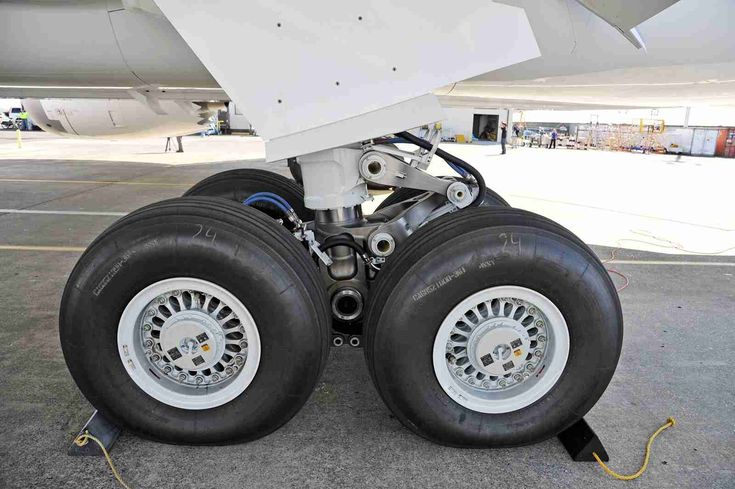 The tire is inflated to the maximum pressure and kept at the same temperature for a certain time. During this time, the pressure inside the tire decreases due to the increase in its dimensions. Next, measure the pressure difference, how much it fell over the allotted time.
The tire is inflated to the maximum pressure and kept at the same temperature for a certain time. During this time, the pressure inside the tire decreases due to the increase in its dimensions. Next, measure the pressure difference, how much it fell over the allotted time. Dynamic
Press Digest for December 6, 2019 | Digest of publications for December 6, 2019
The copyright for this material belongs to the journal Science and Technology. The purpose of including this material in the digest is to collect the maximum number of publications in the media and messages of companies on aviation theme. AviaPort Agency does not guarantee the reliability, accuracy, completeness or the quality of this material.
The purpose of including this material in the digest is to collect the maximum number of publications in the media and messages of companies on aviation theme. AviaPort Agency does not guarantee the reliability, accuracy, completeness or the quality of this material.
The modern aircraft tire is a complex, high-tech structure designed to handle enormous speeds and loads at the highest possible weight and size. Despite this, the tire is one of the least understood and most underestimated elements of an aircraft. Everyone will agree that they are "dirty, black and round." But in reality, an aircraft tire is a multi-element component constructed from three materials: cord, rubber, and metal. By weight, an aircraft tire is 50% rubber, 45% cord and 5% metal. Digging into the component materials in more detail, you can see the different types of rubber compounds and nylon cords. They have their own special properties for the successful completion of tasks.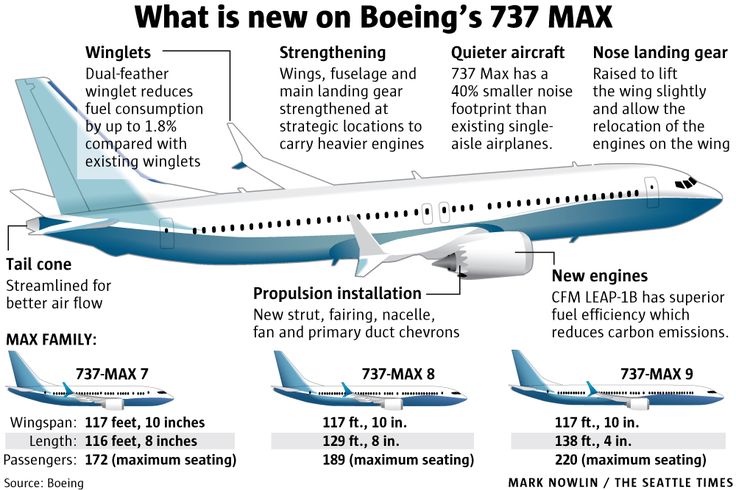
All aircraft tires can be divided into 2 categories:
Before mounting a tire on an aircraft wheel, a series of tests are carried out on it.
These test checks are divided into static and dynamic.
Static
1. Strength test under internal hydraulic pressure. Method: a tire is mounted on a test wheel and pumped with water to the point of rupture. For a certain time, the tire must withstand the load without destruction.
2. Determination of tire pressure on the wheel rim. One of the methods is copying. Place one copy sheet between two sheets of plain paper. Then this paper "structure" is installed between the wheel flange and the tire bead. Next, the tire is pumped up. When the heel of the wheel bead touches the vertical surface of the flange, the fit pressure on the rim is recorded. This will be reflected in the form of a trace on plain paper from the copy sheet.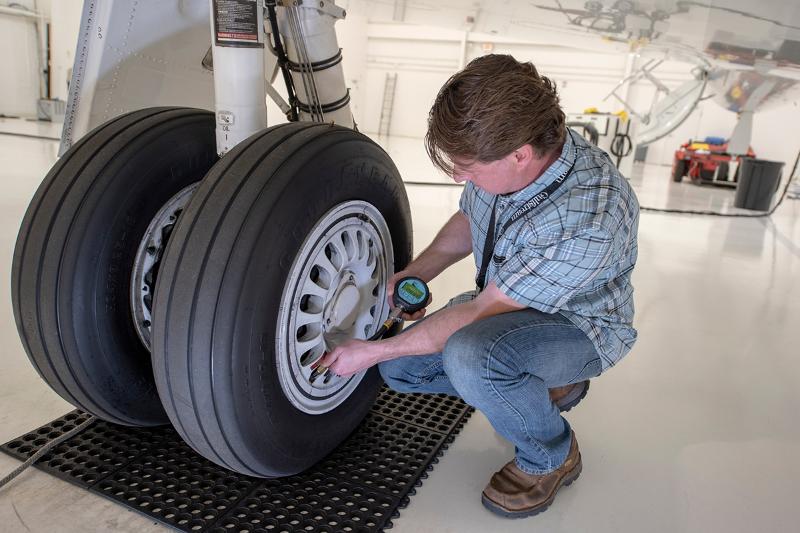
3.Identification of the tightness of tubeless aircraft tires. The tire is inflated to the maximum pressure and kept at the same temperature for a certain time. During this time, the pressure inside the tire decreases due to the increase in its dimensions. Next, measure the pressure difference, how much it fell over the allotted time.
4. Determination of tire dimensions. The aircraft tire is installed on the wheel, pumped up to the maximum nominal pressure. A certain time is kept at room temperature. After the end of this time, the tire is pumped up to its original value. Then the following values are measured: outer width, outer diameter, width and diameter along the shoulder area.
Dynamic
The influence of the curvature of the drum is taken into account.
2. Carrying out dynamic tests of tires in conditions as close as possible to operation: for speed, load, etc.
How to change jet tires
Aircraft tires are admired in the air and safe on the ground.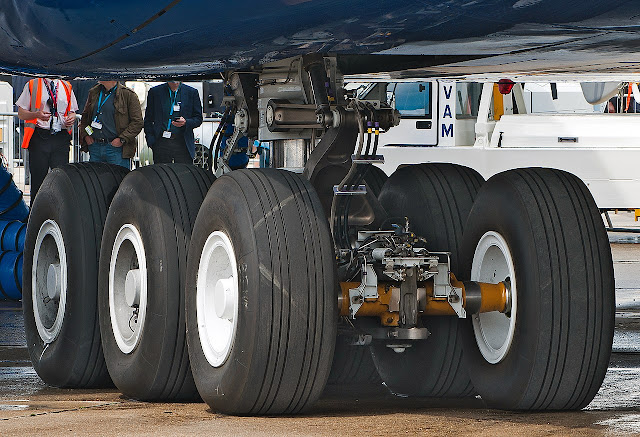 But landings and takeoffs have a negative impact on their condition.
But landings and takeoffs have a negative impact on their condition.
During the year, an aircraft travels a distance of 8 thousand kilometers on the ground, taxiing, maneuvering, flying in and landing. Contacts of aircraft landing gear elements with the runway strongly affect tire wear. Changing tires is a real problem for airlines because it costs a lot of money, but for air carriers, safety always comes first. A qualified team of tire fitters is required to complete the change within 30 minutes.
Frankfurt has one of the busiest international airports and is home to one of the largest airlines, Lufthansa.
The aircraft taxis to the parking lot, a team of specialists begins work. The beginning of the process is very similar to replacing car tires, the only difference is that if the car has 4 wheels, then the aircraft has as many as 30. Blocks of 8 pieces are located under the nose and wings and are attached to the so-called. carts. The trolley is lifted using a jack. The jack's hydraulic pump uses the pressure inside the tire.
The jack's hydraulic pump uses the pressure inside the tire.
after an emergency landing
Having lifted the structure, the team removes the wheel. First, the specialist unscrews the fixing nut. From the skillfully honed movements of the mechanics, it can be seen that the work is ordinary. The price of a mistake is high and is measured by the lives of people who will fly this plane. Mechanics need to know when it is time to change a tire. Diagnostic markers for this are located in the tread grooves. If these indicators are not visible, then the tire needs to be changed.
When you remove a tire, you can see its huge dimensions: width - 0.5 m, diameter - 1.5 m.
Aircraft tires are under enormous stress. For several hours they are in conditions of very low temperatures, and during the landing of the aircraft they pick up speed up to 280 km / h. When landing, the tire temperature is 260°C. Why, then, do these components not explode in the air and burst on contact with the runway pavement?
The secret is inside the tire: it is not filled with compressed air, like a tire, but with nitrogen gas.